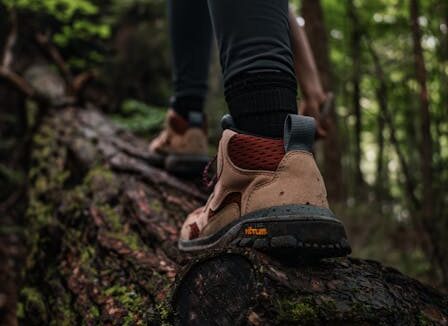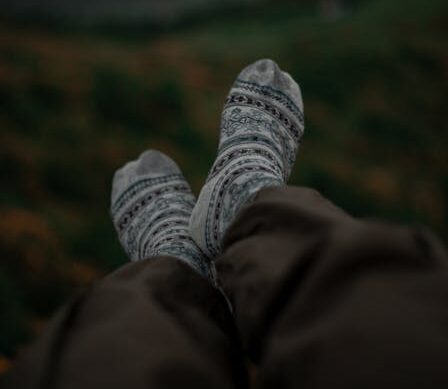
Let’s get real for a minute: hiking blisters are the absolute worst. They turn what should be an awesome day out in nature into a painful slog.
Yes, they even happen to the most seasoned of hikers, including me. Not that long ago I was on a day hike in boots that I had well and truely worn in and the same thick woollen socks that I usually wear and for some reason, unknown to me, I developed a big blister on the side of my big toe on my right foot!
It hasn’t happened since, because I know how to prevent hiking blisters and I’m about to share that knowledge with you.
What Causes Blisters When Hiking?
Friction
- Friction: This is public enemy number one. When your skin repeatedly rubs against your boots or socks, it leads to cell damage, and soon enough, those clear, fluid-filled blisters show up. Soft, supple skin getting torn apart by the persistent rubbing action isn’t fun.
Pressure
- Pressure: This is another big culprit. Tight spots in your boots or embarrassing sock wrinkles can create pressure points that dig into your skin. It’s kinda like having a pebble in your shoe, but spread out over a larger area.
Moisture
- Moisture: Let’s not forget moisture. When your feet get all sweaty and damp, the skin softens. This softened skin is way more likely to get damaged from friction or pressure. That’s why sometimes, even the most perfect fitting boots and socks can still lead to blisters.
So, there it is. The nasty trio – friction, pressure, and moisture. Once you understand what you’re up against, you’ll be better prepared to tackle them head-on.
Comprehensive Prevention Tips for Hiking Blisters
The Importance of Socks
- Socks: Choosing the right hiking socks is non-negotiable. Go for moisture-wicking socks that dry quickly and offer extra cushioning. When it comes to socks, ditch the cotton. Synthetic or wool socks are where it’s at. Consider adding liner socks for that extra bit of protection. My preference is wool as their thickness adds padding that protects your feet. Always carry a spare pair in your pack. Wet socks are blister moms, and you don’t want that.

Right Fitting Boots
- Boots: The fit of your hiking boots is crucial. Consider if you have a wide or narrow foot and buy boots to suit your foot shape. Boots that are too tight or too loose will cause blisters. Make sure they fit just right, without any uncomfortable spots. This also includes lacing your boots correctly, too loose or too tight can cause friction or pressure. When trying boots on, bring the socks you will wear with them and any orthotics if you use them. If you’re getting new boots, break them in around the house or on short walks before tackling any major trails.
How Foot Care Can Prevent Blisters
- Foot Care: Proper foot care starts even before you hit the trail. Plan ahead by cleaning and waterproofing your boots. This keeps them in good shape and ready to fight off moisture and friction.
- Hot Spots: Don’t ignore hot spots. These are the places on your feet that start feeling uncomfortable before a blister forms. Change out damp socks, and slap on some blister-specific bandages or high-quality tape to reduce the friction right away.’
- Lubricants: These can also be a lifesaver here. Petroleum jelly, specialist foot lube to the areas where you feel friction can make a world of difference. Foot powders can also help. Applying these before hitting the trail reduces friction and keeps your feet dry.
Importance of Proper Footwear Care
- Care: Taking good care of your footwear isn’t just about making them last longer —it’s also about keeping your feet blister-free. After each hike, give your boots a good clean. Mud, dirt, and sweat buildup can make them less effective, letting moisture seep in and cause trouble.
- Waterproofing: Waterproofing your boots is another critical step. This keeps them dry, which means fewer chances for moisture-induced blisters. Look for high-quality waterproofing sprays or waxes designed for your type of boots. My boots are already waterproof as they are lined with a waterproof material, so I don’t do this but I do keep them clean.
Letting Your Feet Breathe During Hikes
Give your feet some fresh air during breaks. It might sound simple, but it’s super effective. Remove your boots and socks whenever you take a breather on the trail. Letting your feet cool and dry out can go a long way in preventing blisters.
Think of it as a mini-vacation for your feet. Pulling off your footwear helps evaporate any sweat and reduces moisture build-up. It’s like hitting a reset button, refreshing your skin and keeping those trouble spots at bay.
If you’re taking a longer break, consider giving your feet a quick wipe with a clean cloth or wet wipes. This helps remove any grit or sweat that’s accumulated. A little bit of fresh air can make your feet feel a lot better and keep potential blisters from forming.
I’ve been on hikes where we’ve lunched by a creek and have taken the opportunity to dip my feet in the cool refreshing water. It make a huge difference to how I’ve felt, invigorating me with a surge of energy. Just make sure your feet are dry before putting your socks and shoes back on.

Treatment Tips for Existing Blisters
Dressing to Ease Blisters
Blister padding is a must to protect an existing blister. Use Molefoam with a hole cut out for the blister itself. Surround this with Moleskin or some good-quality tape for added protection.
Blister bandages are your next best friend. Use pads and gels specifically designed for blisters to cushion and soothe the affected area.
Draining a Blister
Consider carefully whether to drain a blister. I would only drain a blister that was getting bigger, extremely painful, I’m talking hindering your ability to walk or likely to be further irritated. The fluid-filled blister keeps the underlying skin clean, which prevents infection and promotes healing.
But if you do need to drain a blister? Here’s how to do it safely
- Wash the area thoroughly.
- Sterilize a needle—holding it over a flame for a few seconds works well or use an antiseptic wipe to clean it.
- Gently puncture the blister.
- Drain the fluid, but leave the overlying skin intact. That skin serves as a natural barrier against infection.
- Cover the blister with antibiotic ointment and gauze or a clean bandage.
- Keep an eye out for signs of infection like redness, increasing pain, pus, or red streaks extending from the blister.
- Got a gnarly blister that’s giving you trouble? Treat it like any wound. Keep it clean, protected, and monitor it closely.
Here is expert advice from The Mayo Clinic on how to treat a blister.
Additional Advice for Blister Care
- Learning first aid and blister care techniques through wilderness medicine classes can be a game-changer. Knowing what to do can save you from a lot of pain and hassle.
- Follow any advice your physician gives you for foot care, and always carry a small blister kit during hikes. Better safe than sorry.
- Keep debris out of your boots by using gaiters. And if something does get in, stop and shake it out. It’s worth the break.
- Gradually increase your hiking mileage. No need to jump into long hikes right away —building up slowly allows your feet to toughen up, minimizing blister risks in the future.
- I often carry a pair of rubber flip flops with me that I change into after my hike. They are lightweight and allow my feet to breath after a long hike.
My Blister
So what have I done to prevent my blister from reoccurring? I have re-thought my footware and now wear two pairs of socks, which have given me the extra cushioning I must have needed and I haven’t had a blister since.
Our feet are precious, they carry all the load and step by step take us to beautiful places, allowing us to enjoy nature. Give them the love they deserve.
Happy hiking!
Have you had a bad boy blister experience? Share it with me, I’d love to help, if I can.

Thanks for the great tips, I’ve always been fond of hiking but today I’ve learnt something totally new, I wasn’t very particular the type of socks to put on, I didn’t know that wearing moisture-wicking socks can really make such a difference in preventing blisters. Do you have any recommendations for blister prevention in different weather conditions? As in does the same type of socks still apply in all weather conditions or different weather conditions require specific footwear?
Hi Elias, I wear the same socks and shoes all year round. The cushioning that thick socks gives makes a huge difference. As for shoes the terrain doesn’t really change so I use my trusted hiking boots.
Hey. I think that preventing blisters is crucial to having a good hike. I know that I’ve had my hikes negatively reflected by blisters in the past. I had no idea that socks were so important. As in the type of socks that you’re wearing. I’ll have to make sure I change that for next time. Anyway this is a fantastic resource for people.
I’ve had my fair share of blisters from hikes, and it’s never fun dealing with them afterward haha the tips you shared about choosing the right socks and breaking in new boots were spot on. I started using blister prevention tape and made sure to wear moisture-wicking socks, and it’s made a huge difference. Thanks for the practical advice!
Your article on preventing hiking blisters provides helpful tips for precautions to take when hiking. I found the information relevant for avid walkers like myself as blisters are bound to occur for any of the reasons you have identified in the article following a long walk. Indeed tightly fitting shoes, poor-quality socks and damp feet can result in blisters forming. Your suggestions for preventive action are useful and I found the tips on what to do should the blisters occur equally informative. Taking proactive action by looking after our feet ensures we reduce the incidents of nasty blisters when out and about. Thank you for your insightful article.